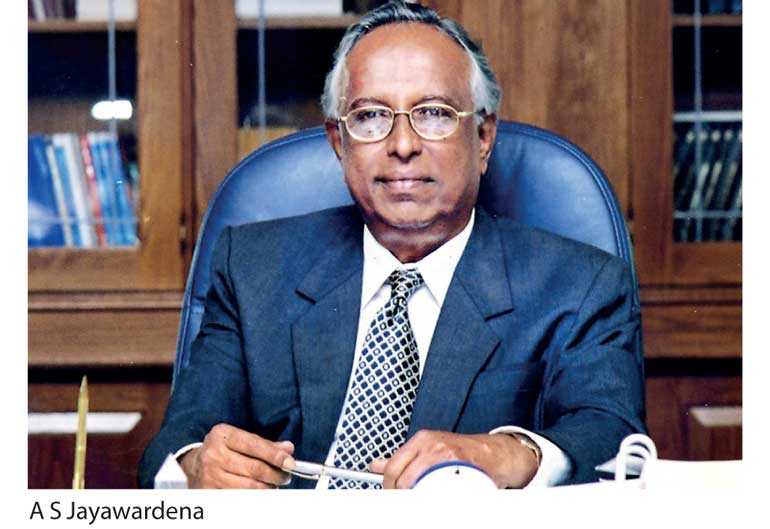Monday Mar 17, 2025
Monday Mar 17, 2025
Friday, 1 June 2018 00:00 - - {{hitsCtrl.values.hits}}

By P. Samarasiri
Economic policy actions implemented by the Central Bank under the stewardship of A.S. Jayawardena in the interest of public economic wellbeing are countless and the institutional memory is fading away.
Many systems and policies prevailing in the Central Bank at present are to his credit. I wish all who worked under A.S. Jayawardena come forward and recall those policies so that new policymakers in the country learn how to manage the macroeconomy with a clear, long-term wisdom.
Recently, there was a big noise in the economic and financial media on the depreciation of the currency and talks on the debt-ridden international reserve to bail-out the currency. As usual, excessive speculation and market manipulation also are major factors in unhealthy movements of exchange rates, similar to interest rates and securities prices.
This situation has to be partly handled by specific regulations and investigations into market abuses of dealers while a long-term macroeconomic policy package is implemented to fix the structural balance of payment problem which is the root cause of the currency problem.
One such example is how the Central Bank handled the currency float on 23 January 2001 and resulting heavy speculation on the currency with a specific policy package designed and implemented under the stewardship of the then Governor A.S. Jayawardena, a veteran all round central banker, who had the macroeconomic policy wisdom.
The rupee was floated on 23 January 2001 by abandoning the exchange rate band of the Central Bank, i.e., buying rate of Rs. 77.40 and selling rate of Rs. 85.13 per US Dollar. As a result, the exchange rate/currency depreciated to around Rs. 98 within the course of the next two days due to excessive speculation and collusive behavior of some dealers identified. This happened partly because the market did not have any guidance as to what could be the market exchange rate immediately after the float of the currency. The market became panic.
The policy package implemented by the Central Bank to control the situation covered the maximum limit of bank foreign currency net position, suspension of pre-payment of imports, 50% margin deposit on bank forward sale contracts and recovery of accommodation to exporters only from export proceeds with maximum 90-day recovery period and excessive penal rates on delays of repayment of export credit. Each policy had a clear wisdom to control undue speculation.
The bank supervision officers examined banks daily to ensure that banks were disciplined and complied with these requirements to the letter and spirit. A daily report was submitted to the Governor for information on the progress. With the policy package and aggressive moral suasion on banks, the exchange rate settled at around Rs. 86-87 within about two weeks. The situation was handled quietly and cautiously without any talks of complacency and big news. Only few in the Central Bank may recall the story.
The currency float which the Central Bank has been managing hitherto is a historic landmark of the Sri Lankan economy. If the float was not managed at that time in that way, the economy probably would have got into crisis. It was a really stressful time in the Central Bank.
The same policy package was re-implemented in 2009 too to control the currency market. Two of the policies, i.e., bank foreign exchange position limit and recovery of accommodation to exporters, are still effective, but with subsequent relaxations. Currency dealers care about their profit and not the national interest of the currency value.
Unlike in January 2001, the market now after 17 years must be more matured and disciplined under the surveillance of the Central Bank and, therefore, any excessive depreciation of the currency has to be connected with some way of collusion if the Central Bank says that there is no underlying fundamental for such a high rate of depreciation.
If we recall how A.S. Jayawardena monitored the foreign exchange and money markets and handled the underlying policies through his long career in the Central Bank, there is no doubt that the present economic policymakers would be able to benchmark their policies for solutions of same problems still prevailing.
Discover Kapruka, the leading online shopping platform in Sri Lanka, where you can conveniently send Gifts and Flowers to your loved ones for any event including Valentine ’s Day. Explore a wide range of popular Shopping Categories on Kapruka, including Toys, Groceries, Electronics, Birthday Cakes, Fruits, Chocolates, Flower Bouquets, Clothing, Watches, Lingerie, Gift Sets and Jewellery. Also if you’re interested in selling with Kapruka, Partner Central by Kapruka is the best solution to start with. Moreover, through Kapruka Global Shop, you can also enjoy the convenience of purchasing products from renowned platforms like Amazon and eBay and have them delivered to Sri Lanka.
Discover Kapruka, the leading online shopping platform in Sri Lanka, where you can conveniently send Gifts and Flowers to your loved ones for any event including Valentine ’s Day. Explore a wide range of popular Shopping Categories on Kapruka, including Toys, Groceries, Electronics, Birthday Cakes, Fruits, Chocolates, Flower Bouquets, Clothing, Watches, Lingerie, Gift Sets and Jewellery. Also if you’re interested in selling with Kapruka, Partner Central by Kapruka is the best solution to start with. Moreover, through Kapruka Global Shop, you can also enjoy the convenience of purchasing products from renowned platforms like Amazon and eBay and have them delivered to Sri Lanka.